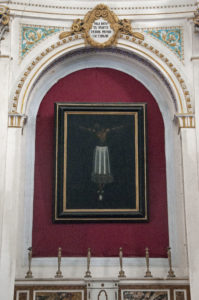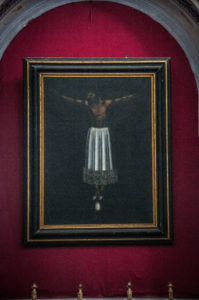As you enter the church of San Giovanni Evangelista (St. John the Baptist), the perception of the bright and scenic space is also given thanks to the works housed within it: endless frescoes, paintings, altars, iridescent stucco, stained glass windows, decorations and ornaments.
There is one work that stands out from the others. The Burgos crucifix, commonly known as “Christ in a skirt”, is a painting that depicts the crucifixion.
The uniqueness of this work lies in its iconography and depiction. The background of the painting is so dark that you can barely make out the wooden cross. Christ’s pose is traditional: arms open, feet fixed to the cross, wounded body and his defenceless head leaning to one side wearing the crown of thorns. What differs from common depictions is the embroidered white garment, with its soft grey shades that emphasise its movement, placed between the waist and ankles.
Below the nailed feet are two silver cups, whose iconographic meaning is unknown, and an ostrich egg, a symbol of resurrection.
On the work you can read the date 1696, but the name of the artist, probably Spanish, is not visible.
The painting could be a donation from the Di Stefano family (Giovanna Di Stefano founded the monastery and was married to Don Girolamo Ribera of Toledo, Spain) or may have arrived at the monastery as a gift from an aristocratic nun.

